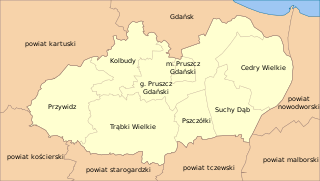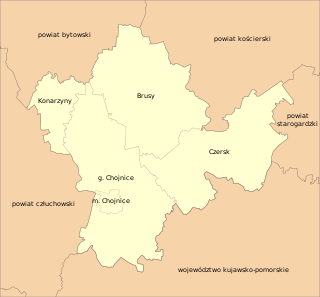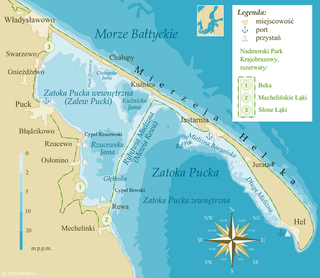
Wielka Piaśnica is a village in the administrative district of Gmina Puck, within Puck County, Pomeranian Voivodeship, in northern Poland. It lies approximately 14 kilometres (9 mi) west of Puck and 46 km (29 mi) north-west of the regional capital Gdańsk.

Starogard County is a unit of territorial administration and local government (powiat) in Pomeranian Voivodeship, northern Poland. The name is a combination of two terms: stari which is Slavic for old and gard which is Pomeranian language stands for town, city, fortified settlement. In this meaning, the term gard is still being used in the only surviving dialect of the Pomeranian, Kashubian language. The county came into being on January 1, 1999, as a result of the Polish local government reforms passed in 1998. Its administrative seat and largest town is Starogard Gdański, which lies 45 kilometres (28 mi) south of the regional capital Gdańsk. The county contains three other towns: Skarszewy, 13 km (8 mi) north-west of Starogard Gdański, Skórcz, 19 km (12 mi) south of Starogard Gdański, and Czarna Woda, 33 km (21 mi) south-west of Starogard Gdański. Starogard County is part of the area traditionally inhabited by the Kociewiacy ethnic group.

Gdańsk County is a unit of territorial administration and local government (powiat) in Pomeranian Voivodeship, northern Poland. It came into being on January 1, 1999, as a result of the Polish local government reforms passed in 1998. It includes areas to the east and south of the city of Gdańsk, from which the county takes its name, although the city is not part of its territory. The county seat and only town in Gdańsk County is Pruszcz Gdański, which lies 12 kilometres (7 mi) south of central Gdańsk.

Człuchów County is a unit of territorial administration and local government (powiat) in Pomeranian Voivodeship, northern Poland. It came into being on January 1, 1999, as a result of the Polish local government reforms passed in 1998. Its administrative seat and largest town is Człuchów, which lies 115 kilometres (71 mi) south-west of the regional capital Gdańsk. The county also contains the towns of Czarne, lying 28 km (17 mi) west of Człuchów, and Debrzno, 16 km (10 mi) south-west of Człuchów.

Chojnice County is a unit of territorial administration and local government (powiat) in Pomeranian Voivodeship, northern Poland. It came into being on January 1, 1999, as a result of the Polish local government reforms passed in 1998. Its administrative seat and largest town is Chojnice, which lies 103 kilometres (64 mi) south-west of the regional capital Gdańsk. The county also contains the towns of Czersk, lying 30 km (19 mi) east of Chojnice, and Brusy, 24 km (15 mi) north-east of Chojnice.

Sztum County is a unit of territorial administration and local government (powiat) in Pomeranian Voivodeship, northern Poland. Its administrative seat and largest town is Sztum, which lies 56 kilometres (35 mi) south-east of the regional capital Gdańsk. The only other town in the county is Dzierzgoń, lying 21 km (13 mi) east of Sztum.

Tczew County is a unit of territorial administration and local government (powiat) in Pomeranian Voivodeship, northern Poland. It came into being on January 1, 1999, as a result of the Polish local government reforms passed in 1998. Its administrative seat and largest town is Tczew, which lies 31 kilometres (19 mi) south of the regional capital Gdańsk. The county also contains the towns of Pelplin, lying 20 km (12 mi) south of Tczew, and Gniew, 31 km (19 mi) south of Tczew. The county is part of the area traditionally inhabited by the Kociewiacy ethnic group.

The Piaśnica is a river in northern Poland, in Puck County near Gdańsk, in Pomeranian Voivodeship. It begins inside the Puszcza Darżlubska Wilderness, located in the northernmost part of the geographical region of Pobrzeże Kaszubskie. Darżlubie Forest contains two nature reserves. On the south–side it borders the Tricity Landscape Park from which, it is separated by the Reda river. The wilderness, is also the source of river Gizdepka. The name of Piaśnica comes from the nearby villages of Piaśnica Mała and Piaśnica Wielka.
Gmina Dynów is a rural gmina in Rzeszów County, Subcarpathian Voivodeship, in south-eastern Poland. Its seat is the town of Dynów, although the town is not part of the territory of the gmina.
Gmina Kosakowo is a rural gmina in Puck County, Pomeranian Voivodeship, in northern Poland. Its seat is the village of Kosakowo, which lies approximately 14 kilometres (9 mi) south-east of Puck and 27 km (17 mi) north of the regional capital Gdańsk.
Gmina Krokowa is a rural gmina in Puck County, Pomeranian Voivodeship, in northern Poland. Its seat is the village of Krokowa, which lies approximately 18 kilometres (11 mi) north-west of Puck and 56 km (35 mi) north-west of the regional capital Gdańsk.
Gmina Wejherowo is a rural gmina in Wejherowo County, Pomeranian Voivodeship, in northern Poland. Its seat is the town of Wejherowo, although the town is not part of the territory of the gmina.

Piaśnica is a former settlement in the administrative district of Gmina Krokowa, within Puck County, Pomeranian Voivodeship, in northern Poland. It lies approximately 9 kilometres (6 mi) north-west of Krokowa, 27 km (17 mi) north-west of Puck, and 64 km (40 mi) north-west of the regional capital Gdańsk.

Mała Piaśnica is a village in the administrative district of Gmina Puck, within Puck County, Pomeranian Voivodeship, in northern Poland. It lies approximately 12 kilometres (7 mi) west of Puck and 44 km (27 mi) north-west of the regional capital Gdańsk.

Mieroszyno is a village in the administrative district of Gmina Puck, within Puck County, Pomeranian Voivodeship, in northern Poland. It lies approximately 13 kilometres (8 mi) north-west of Puck and 53 km (33 mi) north-west of the regional capital Gdańsk.

The massacres in Piaśnica were a set of mass executions carried out by Nazi Germany during World War II, between the fall of 1939 and spring of 1940 in Piaśnica Wielka in the Darzlubska Wilderness near Wejherowo. The exact number of people murdered is unknown, but estimates range between 12,000 and 14,000 victims. Most of them were Polish intellectuals from Gdańsk Pomerania, but Poles, Jews, Czechs and German inmates from mental hospitals from General Government and the Third Reich were also murdered. After the Stutthof concentration camp, Piaśnica was the largest site of killings of Polish civilians in Pomerania by the Germans, and for this reason is sometimes referred to as the "second" or "Pomeranian" Katyn. It was the first large scale Nazi atrocity in occupied Poland.

Puszcza Darżlubska or Lasy Piaśnickie located in northernmost part of Poland, is a Polish forests complex on the Baltic Sea, within the geographical region of Pobrzeże Kaszubskie; on the south-side bordering the Tricity Landscape Park from which it is separated by the Reda river. Inside Darżlubie Forest there are two nature reserves. The wilderness is also the source of two rivers: Piaśnica and Gizdepka. The name of Puszcza Darżlubska comes from the nearby village of Darżlubie in the administrative district of Gmina Puck, north of Gdańsk.

Wejherowo County is a unit of territorial administration and local government (powiat) in Pomeranian Voivodeship, northern Poland, on the Baltic coast. It came into being on January 1, 1999, as a result of the Polish local government reforms passed in 1998. Its administrative seat and largest town is Wejherowo, which lies 36 kilometres (22 mi) north-west of the regional capital Gdańsk. The county also contains the towns of Rumia, lying 11 km (7 mi) east of Wejherowo, and Reda, 7 km (4 mi) east of Wejherowo. Rumia, Reda and Wejherowo are contiguous, and are referred to as the Kashubian Tricity, an allusion to the larger Tricity area centred on Gdańsk.

Gmina Władysławowo is an urban-rural gmina in Puck County, Pomeranian Voivodeship, in northern Poland. Its seat is the town of Władysławowo.
























